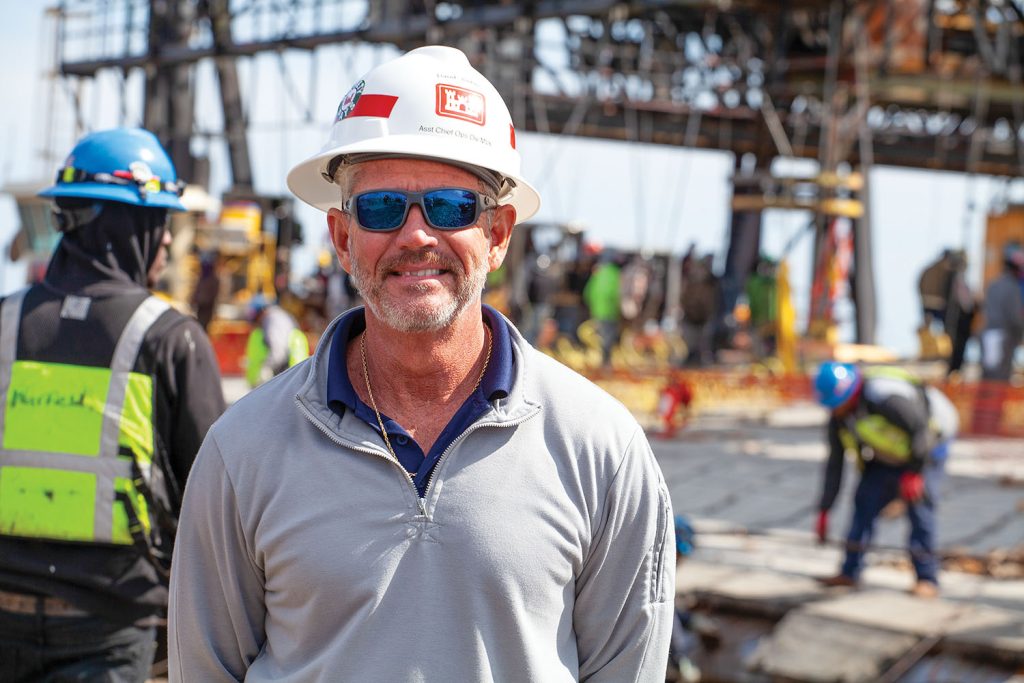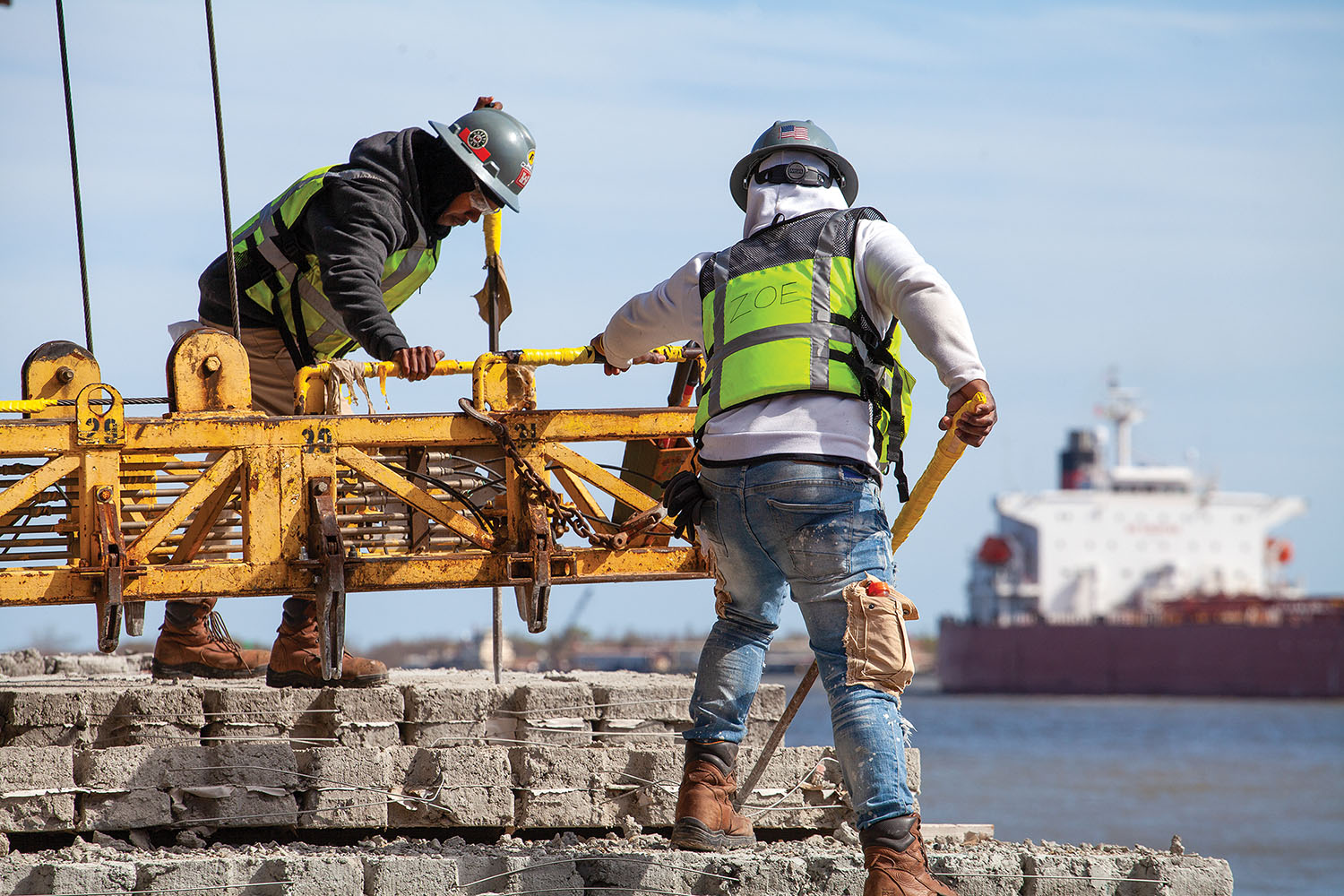For more than three quarters of a century, the Vicksburg Engineer District’s Mat Sinking Unit (MSU) has deployed in low-water months anywhere from Cairo, Ill., to Head of Passes near Venice, La., to armor the banks of the Mississippi River with an articulated concrete mattress to stabilize the river bottom and counteract scouring and erosion.
The Mississippi River, after all, is prone to meander, and oftentimes scouring is the first hint of its intentions.
“That river wants to re-plumb itself all the time,” said David Jenkins, deputy chief of operations division for the Vicksburg District. “The river packs a huge punch.”
The mission to keep the river in its course is no small task, and revetment, the technical term for lining the river bottom to counteract scouring, is just one part.
The Corps surveys the river each year, noting problem spots and prioritizing scours that are growing. Once the MSU’s task order is set, its assets and workforce—close to 300 strong—mobilize and get to work. The bank grading crew sinks cable anchors near the waterline and smooths out the riverbank where the unit will lay mat. A sprawling quarter barge sets up nearby, with MSU personnel driving in and parking along the levee.
Carrying out the main work of revetment are the mat laying barge, the mooring barge, a deck barge loaded with concrete “squares” that measure 4 feet by 25 feet, and the upper and lower set barges that anchor the whole operation in place.
The MSU fleet also includes crew boats, a couple of Corps towboats and a contract towboat that transport equipment and crews to and from the work site. The MSU’s quarter barge generates its own electricity and supplies its own water, and the hard-working mat-laying crew eats three meals a day there. For the midday meal, the entire mat-laying crew is ferried back to the quarter barge and fed in just over half an hour.

On board the mat-laying barge, four crane operators lift the concrete “squares” from the deck barge into place on the mat deck. Crew members then use pneumatic tie tools that weigh 55 pounds and resemble jackhammers to tie the squares together. Once a section of the concrete mattress is tied together, winches aboard the mooring barge and the mat-laying barge roar to life as they slowly slide the concrete mat overboard and down to the riverbed, while the mat-laying barge itself slides away from the bank, little by little.
The MSU is a complex operation that, while rarely seen by the public, is essential to the viability and stability of the Mississippi River and Tributaries system.
Chris Johnson, safety and occupational health specialist for the Mat Sinking Unit, called the operation both “organized chaos” and a “synchronized dance.”
The MSU crew spent the first half of March on the east bank of the Mississippi River, just down from Neptune Pass, a large and growing crevasse across from Buras, La., that connects the river and Breton Sound.
It’s not the first time the MSU has laid mat in that location. Old, undermined concrete squares dot the shoreline, evidence of the river’s force. On the east bank of the river, the federal levee system ends at Bohemia, about 20 miles upriver, making the mat-laying effort below Neptune primarily a navigation and bank stabilization effort.
“We’re trying to keep the river from taking out what’s left of the bank,” Johnson said March 11, speaking to a team from the Vicksburg District that had traveled to southern Plaquemines Parish to tour the MSU.
Jenkins said the current revetment season has been unusually short. Typically, the MSU works from late summer through the fall, during what’s normally the Mississippi River’s low-water season. For the last half of 2023, though, the MSU couldn’t go out because the mooring barge was on drydock for repairs. Fortunately, the river’s “high-water” season so far is low, so the unit has been able to bounce around to address the highest priority spots the past couple of months.
“We typically don’t like to skip around, but this year we had no choice,” Jenkins said.
When this abbreviated revetment season ends next month, the mooring barge will go back to the shipyard for more work, Jenkins said. Ultimately, the Corps will have to replace the mooring barge. While the mooring barge is essentially a deck barge, it’s outfitted with offices, machine shops, winches and all the other components that allow it to hold the mat-laying barge in place. Thus, current cost estimates place a new mooring barge in the $40 million to $50 million range, Jenkins said.
Following its visit to the MSU, the team from Vicksburg traveled to Thoma-Sea shipyard in Lockport, La., March 12 to track the progress of Armor 1, the eventual replacement for the current mat-laying barge. The Armor 1 project got underway in 2017 with design work and prototyping at the National Robotics & Engineering Center (NREC) in Pittsburgh. Construction contracts were awarded in 2019. The design is a collaboration between the Vicksburg District, the Corps’ Marine Design Center, SIA Solutions LLC, Bristol Harbor Group Inc. and NREC. The Corps originally expected Armor 1 to start work this year, but shipyard impacts from COVID-19 and Hurricane Ida led to delays.
“Lockport was ground zero for Ida, and the shipyard got pounded,” Jenkins said. “The biggest impact was from the shipyard losing all its workers because they had no housing.”
Now, Jenkins expects Thoma-Sea to launch the Armor 1 barge in October, with outfitting and sea trials to extend well into 2025.
Jenkins said Armor 1 will be well worth the wait.
“Everything we’re doing on Armor 1 will be safer and more efficient,” he said.
On Armor 1, stitching together the squares will be automated, with an estimated 96 to 98 percent success rate. With that automation, the mat-laying deck crew will shrink from around 100 to around 20, and the new tie tools will be battery-powered and dramatically lighter.
The Corps expects Armor 1 to be able to lay up to 4,000 squares a day, up from a current average of between 1,300 and 2,000 square a day. With 85 percent of MSU injuries occurring on the mat-laying deck, Armor 1 will be much safer to operate as well. Technology aboard Armor 1 will also allow more precise mat placement, Jenkins said.
“We’re going to have sonar that will tell us exactly where the mat is laid,” he said. “That’ll give us a much better product.”
In the meantime, the Vicksburg District is partnering with Hinds Community College in Warren County, Miss., to train crew members on robotics. While the current MSU workforce is a combination of permanent, seasonal (full time) and temporary employees, the unit will transition to a smaller crew of only permanent and seasonal positions once Armor 1 comes online. Total personnel will drop to around 172.
“Mat laying” on the Mississippi River dates to the 1800s, when teams would weave together a mattress of willow trees and sink them with boulders. The Corps substituted concrete for the mattress in the 1920s. The current MSU came online in 1948, with some modifications and additions in 1960. Amazingly, some of the old willow tree mattress remains, Jenkins said.
While the work of the Mat Sinking Unit year after year goes largely unnoticed, its mission is nonetheless crucial to the Mississippi River and the nation.
“With our revetment program, the river has not moved since the 1930s, so it’s working,” Jenkins said.
The next stop for the Mat Sinking Unit is Poydras, La., in St. Bernard Parish, just above English Turn.
Caption for top photo: Two Mat Sinking Unit crew members work aboard the unit’s cement barge just below Neptune Pass near Triumph, La., as the crude oil tanker Xanthos passes by. (Photo by Frank McCormack)




